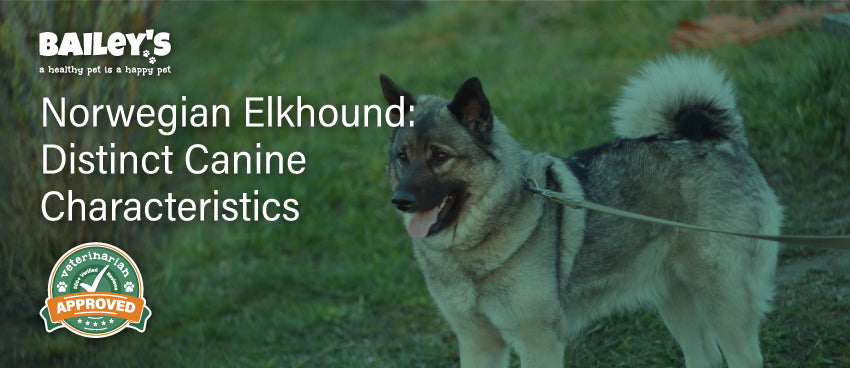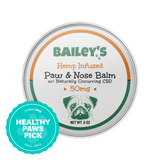Norwegian Elkhound: Distinct Canine Characteristics

The Norwegian Elkhound is a unique and fascinating breed of dog with a rich history and a distinct set of characteristics. If you are considering welcoming one of these majestic canines into your family, it is important to understand what sets them apart.

The friendly folks at Bailey’s CBD are happy to highlight the origin and history, physical attributes, behavioral traits, health and lifespan, and the specific care requirements of these beautiful dogs. We will also discuss their suitability as a family pet. So, let's dive into the world of the Norwegian Elkhound!
Table of Contents
1. Understanding the Norwegian Elkhound Breed
1.1 Origin and History of the Norwegian Elkhound
The Norwegian Elkhound is an ancient breed that has been a loyal and hardworking companion to the people of Norway for centuries. They were originally bred to assist in hunting moose, elk, and other large game, hence their name. With a history dating back more than a thousand years, the Norwegian Elkhound has become an integral part of Norwegian culture.
Legend has it that the Norwegian Elkhound's ancestors were brought to Norway by the Vikings. These fearless explorers recognized the value of having a reliable hunting companion in the rugged Norwegian wilderness. Over time, the breed evolved and adapted to the harsh conditions of the region, developing the traits that make them so well-suited for their hunting duties.
These dogs were highly regarded for their tracking ability, agility, and endurance, making them invaluable assets to Norwegian hunters. Their ability to navigate treacherous terrain and withstand harsh weather conditions made them the ideal hunting companion. They would tirelessly track their prey, using their acute sense of smell to locate and corner the game, allowing the hunters to make the kill.
1.2 Physical Attributes of the Norwegian Elkhound
The Norwegian Elkhound is a medium-sized dog with a sturdy build and an unmistakable appearance. They have a thick double coat, consisting of a dense, soft undercoat and a weather-resistant outer coat. This distinctive coat protects them from the harsh Nordic elements.
Their coat comes in various shades of gray, ranging from light silver to dark charcoal. This coloration helps them blend seamlessly into their natural surroundings, allowing them to stalk their prey undetected. It also gives them a regal and majestic appearance, befitting their noble heritage.
Typically, the Norwegian Elkhound has a wedge-shaped head, erect ears, and a curled tail that rests on their back. Their eyes are dark and expressive, radiating intelligence and determination. They have a keen sense of smell, which is instrumental in their hunting abilities. Their nostrils are wide and well-developed, allowing them to pick up even the faintest scent of their quarry.
In terms of size, male Norwegian Elkhounds generally stand at about 20.5 to 23.5 inches tall at the shoulder, while females stand slightly smaller at 19.5 to 21.5 inches. They weigh between 48 to 55 pounds. These dimensions give them the perfect balance of strength and agility, enabling them to navigate rough terrain with ease.
Despite their strong and muscular build, Norwegian Elkhounds are known for their grace and elegance. Their movements are smooth and fluid, and they possess an innate sense of balance. This combination of physical attributes makes them not only excellent hunters but also versatile working dogs in various other roles.
2. Behavioral Traits of the Norwegian Elkhound
2.1 Temperament and Personality
The Norwegian Elkhound is known for its friendly and outgoing nature. They are intelligent and independent thinkers, but also loyal and devoted to their owners. These dogs thrive on human companionship, making them excellent family pets.
With their sociable and amiable disposition, Norwegian Elkhounds are often sought after as therapy dogs. Their gentle and patient nature allows them to provide comfort and support to those in need, whether it be in hospitals, nursing homes, or rehabilitation centers.
Additionally, Norwegian Elkhounds are typically good with children and other pets if properly socialized from a young age. Their patient and tolerant attitude make them great playmates for kids, and their natural herding instincts can even make them excellent caretakers, keeping an eye on the little ones and gently guiding them away from potential dangers.
However, it is important to note that they have a strong prey drive due to their hunting background. This drive can make them prone to chasing and potentially injuring small animals or wildlife if not supervised or trained properly. It is crucial for owners to provide a secure and fenced-in area for them to roam freely without posing a threat to other animals.
2.2 Training and Exercise Needs
Training a Norwegian Elkhound requires patience, consistency, and positive reinforcement. These dogs have a strong will and an independent streak, so using reward-based methods and establishing yourself as the pack leader is essential.
Due to their intelligence and eagerness to please, Norwegian Elkhounds excel in various dog sports and activities. They can participate in obedience trials, agility courses, and even scent detection competitions. Their natural tracking abilities, combined with their sharp senses, make them ideal candidates for search and rescue missions as well.
Exercise is also crucial for the overall well-being of the Norwegian Elkhound. They have high energy levels and require daily physical activity to keep them mentally and physically stimulated. Regular walks, jogs, and playtime are necessary to prevent boredom or destructive behavior.
Engaging their intellect is equally important. Puzzle toys, obedience training, and activities that tap into their natural instincts, such as scent games, can help keep their minds sharp and prevent them from becoming restless or bored. Providing them with a variety of mental and physical challenges will ensure a happy and well-rounded Norwegian Elkhound.
3. Health and Lifespan of the Norwegian Elkhound
The Norwegian Elkhound is a robust and hardy breed known for its excellent health and longevity. However, like all breeds, they are prone to certain health issues that owners should be aware of. By understanding these conditions and taking proactive measures, you can help ensure a longer and healthier life for your beloved Norwegian Elkhound.
3.1 Common Health Issues
While generally healthy, Norwegian Elkhounds may be susceptible to a few common health issues. One of the most prevalent conditions is hip dysplasia, a genetic disorder that affects the hip joints. Regular veterinary check-ups and early detection can help manage this condition and alleviate any discomfort your dog may experience.
Another health concern in Norwegian Elkhounds is progressive retinal atrophy (PRA), a degenerative eye disease that can lead to vision loss. Regular eye examinations by a veterinary ophthalmologist can help monitor and manage this condition, ensuring your dog's visual health.
Thyroid problems are also seen in some Norwegian Elkhounds. Hypothyroidism, an underactive thyroid gland, can cause weight gain, lethargy, and skin issues. Regular blood tests can help diagnose and manage this condition, ensuring your dog's thyroid levels are within the normal range.
By being proactive and attentive to your Norwegian Elkhound's health, you can help minimize the impact of these common health issues and provide them with a high quality of life.
3.2 Diet and Nutrition Requirements
A well-balanced diet is essential for the overall health and longevity of your Norwegian Elkhound. Feeding them high-quality dog food that is appropriate for their age, size, and activity level is crucial. This will provide them with the necessary nutrients to support their immune system, maintain a healthy weight, and promote optimal growth and development.
It is important to be cautious about overfeeding your Norwegian Elkhound, as excessive weight can put strain on their joints and increase the risk of developing hip dysplasia. Consult with your veterinarian to determine the appropriate portion sizes and feeding schedule for your dog.
In addition to a balanced diet, fresh water should always be available to your Norwegian Elkhound. Hydration is key to maintaining their overall health and well-being.
It is always best to consult with a veterinarian to determine the specific dietary, treat, and supplementary needs of your Norwegian Elkhound. They can provide personalized recommendations based on your dog's age, weight, activity level, and any specific health concerns.
While the Norwegian Elkhound is generally a healthy breed, it is important to be aware of the common health issues they may face. By staying proactive, providing a balanced diet, and seeking regular veterinary care, you can help ensure a long and happy life for your furry friend.
4. Caring for a Norwegian Elkhound
The Norwegian Elkhound is a beautiful and intelligent breed that requires proper care and attention to thrive. In addition to their stunning appearance, they have specific grooming needs and living conditions that should be taken into consideration.
4.1 Grooming Needs
The Norwegian Elkhound's thick double coat is one of its most distinctive features. This coat requires regular grooming to keep it in good condition. Weekly brushing is essential to remove loose hair and prevent matting. Not only does regular brushing help maintain the coat's health, but it also helps to minimize shedding, which can be a relief for those who prefer a cleaner living environment.
During shedding seasons, which occur twice a year, more frequent brushing is necessary to keep the amount of loose hair under control. This is especially important if the Norwegian Elkhound spends a lot of time indoors, as excessive shedding can result in a significant amount of hair around the house.
In addition to brushing, other aspects of grooming are equally important. Regular nail trims are necessary to keep their paws healthy and prevent discomfort or injury. Ear cleaning is also crucial to prevent ear infections, which can be common in dogs with floppy ears. Lastly, dental care is essential to maintain good oral hygiene and prevent dental diseases. Ensuring their teeth are clean and their nails are properly trimmed contributes to their overall health and well-being.

4.2 Suitable Living Conditions
While the Norwegian Elkhound can adapt to various living conditions, including apartments, it is important to provide them with adequate exercise. They are an active breed that requires regular physical activity to stay happy and healthy. However, it is worth noting that they thrive in a home with a securely fenced yard where they can safely release their energy and explore their surroundings.
It is important to consider that Norwegian Elkhounds are highly vocal and have a tendency to bark. This could be a consideration for those living close to neighbors or in apartments with thin walls. Proper training and early socialization can help address this behavior and teach them appropriate times to bark and when to remain quiet.
Additionally, Norwegian Elkhounds are known for their loyalty and protective nature. They make excellent watchdogs and are always alert to their surroundings. This can be a positive trait for those looking for a companion to keep them safe, but it is important to ensure that their protective instincts are properly channeled through training and socialization.
Caring for a Norwegian Elkhound involves regular grooming to maintain their beautiful coat and overall health. Providing them with suitable living conditions, including adequate exercise and a secure yard, is crucial to their well-being. With proper care, training, and socialization, the Norwegian Elkhound can be a wonderful and loyal companion for many years to come.
5. The Norwegian Elkhound as a Family Pet
5.1 Compatibility with Children and Other Pets
As mentioned earlier, Norwegian Elkhounds are generally good with children and other pets. They are gentle, patient, and protective, making them an excellent choice for families.
However, it is important to teach children how to interact with dogs properly and to supervise their interactions to ensure everyone stays safe. Similarly, introducing a Norwegian Elkhound to other pets should be done gradually and under controlled circumstances to ensure a harmonious coexistence.
5.2 The Elkhound's Protective Instincts
One notable trait of Norwegian Elkhounds is their strong protective instincts. They are naturally vigilant and will alert their owners if they sense any potential threats or intruders. This makes them excellent watchdogs.
However, it is important to provide proper socialization and training to prevent excessive guarding behaviors. Early exposure to different people, animals, and situations will help them differentiate between genuine threats and everyday occurrences.
6. Conclusion
In conclusion, the Norwegian Elkhound is a remarkable breed with distinct characteristics that make them both fascinating and wonderful companions. Their rich history, physical attributes, and behavioral traits all contribute to their unique appeal. While they do require some special care and attention, their loyalty, intelligence, and affectionate nature make the Norwegian Elkhound a fantastic addition to any family willing to invest the necessary time and effort into their care. So, if you are looking for a loyal and devoted canine companion, the Norwegian Elkhound might just be the perfect match for you!











